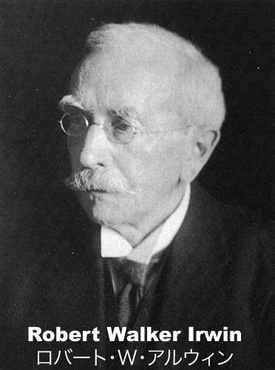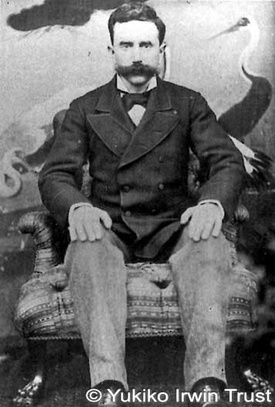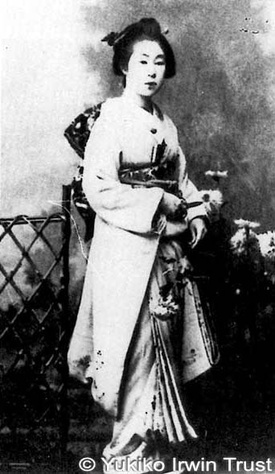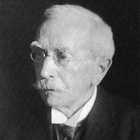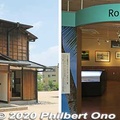*Japanese names in this article follow the Japanese convention of the family name coming before the given name.
Irwin arrives in Yokohama in 1866 during a most tumultuous time in Japan’s history. He soon meets the two most important Japanese people in his personal and business life. One was his wife Iki whom he finally legally married after taking over 10 years to overcome family opposition and legal hurdles. Irwin and Iki became the world’s first American and Japanese nationals to marry.
* * * * *
In June 1860 in Philadelphia, Pennsylvania, 16-year-old Robert Walker Irwin was among the curious onlookers gawking at Japanese men wearing topknots, samurai swords, and haori-hakama attire. The men were the first Japanese Embassy to the United States visiting the city after ratifying the Treaty of Amity and Commerce in Washington, D.C. During their six-day stay in Philadelphia, the Japanese group toured the U.S. Mint, an iron foundry, and a locomotive factory. They even demonstrated the Japanese version of chess called shogi.
Robert was very excited by the exotic-looking visitors, who made an indelible impression on him. They sparked his desire to someday visit the mysterious land of Japan.
His dream to visit Japan came true at age 22 in November 1866 when he arrived to staff the Japan branch of the Pacific Mail Steamship Company in Yokohama. He helped establish the company’s transpacific steamship service between San Francisco, Yokohama, and Hong Kong that started in 1867. The company would later transport Japanese immigrants to Hawai‘i.
Irwin’s privileged family background opened many doors. Through his mother, he was a fifth-generation direct descendant of Benjamin Franklin. The position of Irwin’s father, William, a diplomat and politician, placed the Irwin family in Pennsylvania’s high society. His older brother Richard secured the job for Robert at the Pacific Mail Steamship Company.
Irwin arrived in Yokohama during an amazing and pivotal historical period in Japan. Just a year after Irwin arrived, Tokugawa Yoshinobu abdicated as shogun to return governing power to the emperor in November 1867. Less than a year later in October 1868, the Meiji Period began with Emperor Meiji moving from Kyoto to Edo (renamed “Tokyo”). In 1872, Japan’s first railway opened between Tokyo and Yokohama.
Irwin would witness the samurai nation transform itself into a major world power called the Empire of Japan, which defeated China in the First Sino-Japanese War in 1895 and shockingly defeated Russia in the Russo-Japanese War in 1904–1905. Irwin was quite fixated on the Russo-Japanese War with his private collection of woodblock prints and other memorabilia of the war. During World War I, Japan declared war on Germany in 1914 and seized Germany’s colonies in Micronesia. By Irwin’s death in 1925, the Empire of Japan included Taiwan, Korea, parts of China, and Micronesia.
Business and marriage in Japan
After Japan opened trade to the West through “unequal treaties” like the Treaty of Amity and Commerce with the U.S. in 1858, major business opportunities arose. With Japan’s industrial revolution and modernization of its military, foreign trade with Japan became a booming business, attracting businessmen like Irwin.
After leaving the Pacific Mail Steamship Company, Irwin embarked on a career in foreign trade, first with Walsh Hall & Co., a prominent American trading firm in Yokohama that sold warships, weapons, and gunpowder to the shogunate and daimyo, and procured rice, tea, and silk for markets in the United States. Irwin did well there and by around 1870 was running the company’s Nagasaki office.
Around that time, Irwin met two people who would become very important in his life in Japan. During a business trip to Yokohama, he stopped at the offices of a foreign currency dealer for a meeting. He was politely served tea and confections by the currency dealer’s young female assistant. Irwin was immediately captivated by the assistant’s beauty and manners. She was Takechi Iki (1851–1940), the 16-year-old adopted daughter of one of the currency dealer’s family friends, a successful wholesaler of marine products near Asakusa in Tokyo. Irwin investigated her family background and found everything about her to be acceptable. Iki was well educated in reading and writing, calligraphy, tea ceremony, flower arrangement, koto playing, and Japanese dance. All because her adoptive family could afford educating her in all these arts.
Irwin started a relentless pursuit for her hand in marriage, despite opposition by both his and her families and all of his American friends in Japan (including his employer, the Walsh brothers). After about two years, he finally convinced Iki and her family of his good intentions, and Robert and Iki were allowed to marry. She was 18 and he was 26. They settled in Nagasaki.
The only problem was that it still was not legal for a Japanese woman to marry an American (and vice versa). Irwin took action and pushed both governments to make such marriages legal. However, it took the Japanese government six years to officially approve the marriage and twelve years for the U.S. government to legalize it.
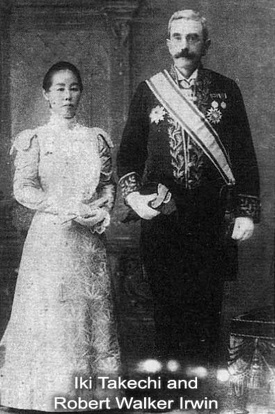
On March 15, 1882, Irwin (38) and Iki (30) were finally legally married, making it the first legal marriage between a Japanese national and American. This allowed their future children to be registered as American citizens at the U.S. Consulate in Tokyo. It was not Japan’s first legal international marriage, which was supposedly between a Japanese man and Englishwoman in the UK in 1873.
The other most important Japanese person Irwin met in Japan was Inouye Kaoru (1836–1915), a major figure in the Meiji oligarchy that took over the reins of government following the demise of the Tokugawa shogunate and samurai feudal system in 1868. Around 1871, Irwin met Inouye, who was then the Vice Minister of Finance. Inouye and the Ministry of Finance were burdened with the task of absorbing the debts of the disbanded samurai domains. Irwin gave Inouye some useful advice on financial negotiations that bore fruit. Inouye came to trust Irwin and continued seeking his advice. Their families also became close friends.
Inouye floated back and forth between government service and private business. In 1874, Irwin helped Inouye and his partners establish Senshu Gaisha, the forerunner to trading company Mitsui Bussan (Mitsui & Co.). Until then, trade with Japan was being handled mainly by foreign companies. With the formation of Senshu Gaisha, there finally was a Japanese trading company. Irwin managed the foreign import-export business for Senshu Gaisha (exporting rice and importing military weapons for the Japanese army) and later managed Mitsui Bussan. His ties to Mitsui continued for the rest of his life.
In July 1876, Irwin arranged a U.S. study trip for Inouye, his wife, youngest daughter, and about twenty assistants and students to tour San Francisco, Nevada, Chicago, Niagara Falls, and the Philadelphia Centennial Exposition. Irwin served as their guide. After visiting the U.S., Inouye and his group toured Europe and returned to Japan in July 1878. It was not Inouye’s first overseas trip. In 1863, he went to study for six months in England at the University College London as one of the famous Choshu Five, sent secretly by the Choshu Domain (Yamaguchi Prefecture).
In 1879, Inouye was lured back to government service to head Japan’s new Foreign Affairs Department and worked as Japan’s first Foreign Affairs Minister until 1885. He thereby served in Japan’s first modern government cabinet with his hometown friend and fellow Choshu Five member, Ito Hirobumi, Japan’s first prime minister. Since Irwin never mastered Japanese (he spoke only broken Japanese to his wife, Iki who spoke only broken English), Inouye must have been happy to practice his English with Irwin. Irwin’s friendship with Inouye proved to be very valuable for Irwin personally, as well as for the Kingdom of Hawai‘i.
© 2020 Philbert Ono


